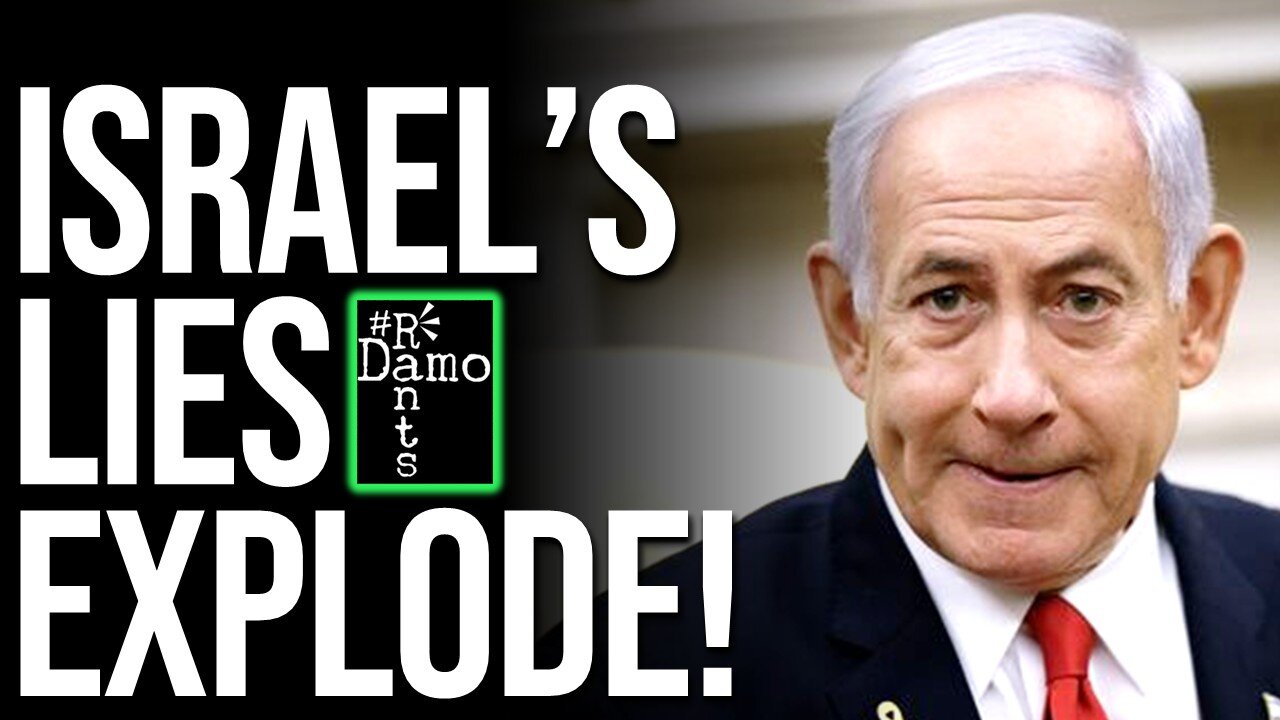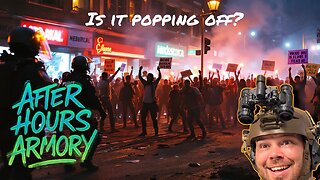Premium Only Content

Israel Poured Millions Into Propaganda – And It’s Blowing Up in Their Face
Right, so Israel spends fortunes on trying to convince us all that we should feel sorry for them, that they are the victims, even as they are the illegal occupiers, the unadulterated aggressors and instigators of unprovoked strikes across multiple different borders, but all in the name of security, because only they are apparently allowed to have any. It hires the biggest names in PR, budgeting for its propaganda like no other nation of Earth does, to tell the world that a war crime filmed in broad daylight is just a “tragic misunderstanding.” But when even the hired mouthpieces will no longer play along, you know the PR varnish has cracked. SKDK — a Democratic powerhouse that usually sells presidents, not pariah states — has just walked out on Tel Aviv, tearing up a fat $600,000 contract and leaving Netanyahu’s government scrambling for a new ventriloquist. Their excuse? The work had “run its course,” but the contract actually ran until next March. So the translation is more like the stench of pushing Netanyahu’s soundbites like a digital David Mencer was too strong. And here’s the punchline: the very propaganda Israel paid to shield itself has become Exhibit A in its humiliation. The spin doctors have now fled, nobody to rewrite the story and so only the truth is left to play out— that Israel’s lies are now utterly unsellable.
Right, so Israel has always fought its wars on two fronts. One is rubble and shrapnel, tanks and drones, siege and starvation. The other is words, images, and slogans — propaganda dressed up as public relations, atrocity polished into “self-defence.” It is this second front, the war for perception, that has long allowed Israel to keep bombing and bulldozing with impunity, providing cover for themselves via the media and those paid to push that narrative, which in turn gives bought and paid for politicians and the like cover to hide behind in defending them against the indefensible. And it is precisely this second front that is now collapsing.
At the end of August 2025, SKDK, one of Washington’s most powerful Democratic-aligned PR firms, abruptly tore up its contract with the Israeli government. This wasn’t a trivial account. It was a $600,000 deal, signed only back in April and scheduled to run until March of next year. It was funnelled through Israel’s state advertising agency Lapam, with the Ministry of Foreign Affairs behind it, and in partnership with European giant Havas. This was meant to be the backbone of Israel’s American propaganda push — and it has crumbled barely halfway through.
The explanation offered by SKDK was almost comical though. The firm claimed the project had “run its course.” That’s like saying a bridge collapsed because it was tired of standing. You don’t shred a contract worth more than half a million dollars with seven months still on the clock unless something has gone catastrophically wrong. And something had. Just days earlier, reporting revealed that the contract was tied to a bot program — an automated digital army designed to flood the internet with pro-Israel messaging. Whether or not SKDK touched that element is beside the point. The mere perception was enough to turn the contract into a reputational death sentence.
This is the grotesque irony at the heart of all of this. SKDK was hired to shield Israel’s image, to launder atrocity into sympathy, they took a paycheck to do that. Instead, the contract itself became a global story - in some media anyway - proof that Israel’s war is so toxic it has to be sold with bots and spin doctors these days, but now even the spin doctors now want out.
To see why this matters, you need to understand how central propaganda is to Israel’s strategy. Militarily, it can bulldoze a refugee camp. Politically, it can count on Washington’s veto at the UN, which we’ve just seen them use yet again. But morally, legally, publicly? Israel is exposed. The International Court of Justice has already declared there is a plausible case of genocide. The International Criminal Court is circling with war crimes charges. Civil society campaigns for sanctions and boycotts are snowballing across the world. Israel cannot afford to let Gaza’s raw images speak for themselves can they? They must be smothered. Buried beneath propaganda. That is why Hasbara, Israel’s propaganda apparatus, exists. That is why contracts like SKDK’s exist.
And yet Hasbara has never been more fragile. It has been pushed into overdrive since 2023: massive ad campaigns on YouTube across Europe portraying the bombing of civilians as “security.” AI-driven “superbots” designed to flood social media conversations with canned talking points, as exposed by Al Jazeera; carefully staged influencer tours, TikTok partnerships, and advertorials that try to bury genocide beneath glossy PR. This isn’t an afterthought. It’s a war machine all of its own. And SKDK’s exit shows that even this machine is beginning to jam.
The anatomy of the contract tells the story. First came the Bibas family tragedy, a calculated choice to humanise Israel’s cause with one photogenic narrative. But when that storyline was drained though, SKDK shifted to booking Israeli officials for sympathetic interviews, filling US television screens with rehearsed lines and empty slogans. That was the respectable face of the operation. But in the shadows was the digital component: the alleged bot program. Fake accounts. Automated amplification. A social media battlefield full of phonies. Whether SKDK pressed the buttons is almost irrelevant. Once the story broke, it didn’t matter. The stink it created was enough.
That is why “run its course” is such a hollow excuse. This wasn’t the natural end of a campaign. It was a scramble for the exit when the heat was on. SKDK did not walk away because the work was complete. It walked because the work had become indefensible. It walked because association with Israel’s war was reputationally toxic. It walked because to stay would have meant branding itself as complicit in a genocide. And once one firm calculates that way, others begin to ask the same questions. Who wants to be the next to carry Israel’s genocidal baggage? Who wants to be caught when the cover story has disintegrated?
This is the essence of the backfire Israel and Netanyahu now face. SKDK was meant to manage Israel’s story. Instead, SKDK became the story and for an agency that wants to run quietly in the background, arranging interviews and allegedly seeding bot farms, to be the focus is the last thing they want. The work they are doing and who they are doing it for not something they would ever want to be publicly associated with. The intended narrative was about Israeli resilience, Israeli tragedy, Israeli self-defence. The actual narrative became that Israel is so toxic, so desperate, so indefensible, that even its hired propagandists are fleeing. What was supposed to shield Israel has exposed it instead.
And the timing makes it even worse. This collapse comes after months of gargantuan spending on propaganda. Israel has poured millions into hasbara across every platform. Entire advertising budgets have been burned on YouTube and Instagram, where smiling narrators reframe massacres as “operations.” Lobbyists have been paid fortunes to shepherd Israeli officials through Capitol Hill. Influencers have been flown to Tel Aviv to pose for selfies while Gaza starves. Every dollar was meant to maintain the illusion of inevitability — that Israel would always dominate the narrative. And then, at the centre of this campaign, SKDK’s contract disintegrates. Suddenly, the millions look like money down the drain. Suddenly, the illusion collapses.
Because SKDK’s retreat doesn’t sit in isolation. It must be seen against the backdrop of Israel’s wider PR blitz, where every attempt at narrative control is already crumbling. Consider the YouTube campaigns across Europe. Israel had been running slick, soft-focus adverts in multiple languages, dropped in front of cooking tutorials, music videos, and children’s content. They had even been showing up on my videos as some viewers had pointed out. The idea was to bypass journalists entirely and deliver propaganda directly into people’s homes. Israel’s bombardment of Gaza was dressed up as a noble stand for “security,” complete with stock footage of happy families and ominous warnings about terrorism. It was a campaign that cost millions. But what did it buy? A flood of complaints from viewers who resented being force-fed propaganda, questions about complicity, and a storm of activist pushback. Far from shielding Israel, the ads exposed it further, making the propaganda itself part of the scandal.
Or take the TikTok influencer tours. Tel Aviv brought in lifestyle influencers, staged photoshoots, and carefully orchestrated trips to restaurants and beaches, while a few miles away Gaza’s population was being starved. The aim was to reframe Israel not as a war zone but as a vibrant, trendy, youthful destination. The problem was obvious: you cannot plaster over mass death with Instagram filters. Screenshots of influencer contracts leaked. Videos were mocked and ratioed. Hashtags turned against them. What was supposed to be a charm offensive turned into a grotesque self-own, a public relations disaster that reinforced exactly what Israel wanted to hide — its cynical attempt to make genocide palatable.
And then there is the even darker frontier: bots and AI. Al Jazeera documented the rise of “superbots,” advanced programs linked to Israeli networks, designed to simulate human users across social platforms. They weren’t crude troll farms — they were engineered to look authentic, to argue, to cajole, to blend in. Their purpose was simple: drown out criticism, flood debates, amplify Tel Aviv’s talking points. But exposure came swiftly. Researchers traced the patterns. Tech platforms announced takedowns. Journalists published damning investigations. Once again, the intended effect backfired. Instead of persuasion, the story became about manipulation. Instead of legitimacy, Israel gained another scandal. If your war requires robots to speak for you, it proves your people are not with you.
This is the environment into which the SKDK implosion landed. Unlike YouTube ads or TikTok influencers, SKDK represented the “serious” wing of Hasbara. This was not flashy marketing but professional lobbying. Its Democratic connections guaranteed access to CNN green rooms and New York Times op-ed pages. It was supposed to be the channel through which Israel’s line could slip unnoticed into respectable discourse. And yet, it is precisely this respectable mask that has now shattered. When even the grown-ups of American PR flee, the entire edifice is on very shaky ground.
But the irony is as delicious as it is brutal. Israel burned millions on social media campaigns that were mocked, influencer tours that were ridiculed, bots that were exposed. But none of that compares to the blow of losing SKDK. For $600,000 — a fraction of the propaganda budget — Israel managed to lose its most prestigious mouthpiece, and in doing so flip the entire story against itself. What was meant to be invisible became visible. What was supposed to smooth over atrocity became evidence of it. The firewall turned into a bonfire.
And here’s the question hanging in the air: what happens when money stops working? Israel has always believed it could buy legitimacy, buy influence, buy silence. It has worked for a long time. It assumed that as long as the cheques kept flowing, if they increased the budget, the PR firms would keep talking. But SKDK’s retreat suggests a tipping point — a world where reputational survival matters more than Israeli contracts. If that calculation spreads, if other firms conclude that Tel Aviv is now a liability, then the propaganda machine itself collapses. Who will carry Israel’s message then? Who will risk their own future to defend Netanyahu’s war? And if no one will, what does Israel have left but the violence that despite all of their propaganda spending we have still borne witness to, for nearly 2 years now?
This is why SKDK’s retreat stings so badly. It reveals that Israel’s propaganda empire, for all its budgets and machinery, is hollow. It is an edifice of illusions that cracks under scrutiny. Every YouTube ad, every influencer selfie, every bot tweet becomes evidence of the cover-up, not a replacement for reality. And reality is louder. Reality is Gaza’s hospitals in ruins, Gaza’s children starving, Gaza’s homes turned to dust. No amount of PR can mute that forever.
For Netanyahu, the humiliation is personal. His entire political identity is bound up with narrative dominance. He built his career on manipulating foreign press, on swaggering at UN podiums, on casting himself as Israel’s indispensable storyteller. He’s dodged corruption scandals and political crises by drowning them in spin. But when even professional spinners refuse to carry his message, the illusion collapses. He is exposed not as master of narrative but as its prisoner.
This is not just a contract dispute. It is a symbolic defeat in the very arena Israel thought it controlled above all else. SKDK’s withdrawal shows that Hasbara itself is cracking under the weight of its own lies. The millions spent are wasted. The credibility is gone. And the question that Israel cannot silence is simple: if even the propaganda machine will not defend you, who will?
Of course if Israel cannot win the propaganda war, they’ll just lash out and in line with that they’ve named three states as apparently being the new axis of evil, Iran 2.0 if you will, but when you see who’s on this hit list of theirs and dig into it a bit, you realise that their claims are getting more desperate and unhinged than ever. Check out this video recommendation here as your suggested next watch to find out all about that story.
Please do also hit like, share and subscribe if you haven’t done so already so as to ensure you don’t miss out on all new daily content as well as spreading the word and helping to support the channel at the same time which is very much appreciated, holding power to account for ordinary working class people and I will hopefully catch you on the next vid. Cheers folks.
-
 1:43:56
1:43:56
Tundra Tactical
13 hours ago $44.44 earned🛑LIVE NOW!! FBI Gets Caught LYING About Good Guys With Guns For 10 YEARS!!!!
70.3K11 -
 LIVE
LIVE
LethalPnda
1 hour agoK-Pop Demon Hunters x Fortnite | Use code LETHALPNDA in the Item Shop!
49 watching -
 2:12:01
2:12:01
BlackDiamondGunsandGear
2 days agoAFTER HOURS ARMORY / Antifa / Lies/ Prison time
42.5K3 -
 2:12:00
2:12:00
DLDAfterDark
13 hours ago $19.25 earnedThe After Hours Armory! Tonight is The Chat's Chat! God, Guns, and Gear!
57.1K6 -
 3:32:18
3:32:18
Mally_Mouse
16 hours ago🌶️ 🥵Spicy BITE Saturday!! 🥵🌶️- Let's Play: Phasmophobia
61.4K6 -
 1:13:19
1:13:19
iCkEdMeL
12 hours ago $27.87 earnedChaos Explodes in Chicago & Portland | Feds Clash with Protesters!
65.7K38 -
 21:54
21:54
Exploring With Nug
1 day ago $11.33 earnedScuba Diving Missing Person Search Leads to Discovery of Classic Cars!
75.9K20 -
 1:19:51
1:19:51
World2Briggs
15 hours ago $2.86 earnedThe US This Week
39.9K8 -
 2:31:13
2:31:13
Joker Effect
12 hours ago"MAKE STREAMING GREAT AGAIN" - Brands Step Up Finally. Birth of Rumble Community. Taking Leadership
25.1K4 -
 5:02:17
5:02:17
Illyes Jr Gaming
16 hours ago"Machine Gun" Takes On BLACK OPS 7 Beta DAY 3!!!
16.2K1
